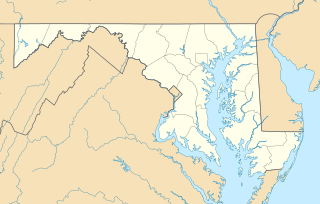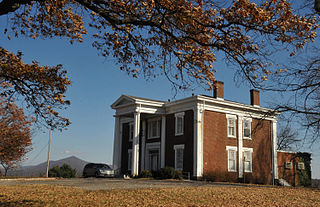
Mount Airy is a city in Surry County, North Carolina, United States. As of the 2010 census, the city population was 10,388.

Warsaw is a town in and the county seat of Richmond County, Virginia, United States. The population was 1,512 at the 2010 census.
Mount Airy is the name of several places in the Commonwealth of Virginia:

Mount Airy station is a SEPTA Regional Rail station at 119 East Gowen Avenue between Devon and Sprague Streets, Philadelphia, Pennsylvania. The station building is listed on the National Register of Historic Places and was built in 1875 with Frank Furness as the likely architect, according to the Philadelphia Architects and Buildings project. The National Register of Historic Places Nomination Form lists the architect as unknown, but notes the similarities to the nearby Gravers station which was designed by Furness. Both stations display an aggressively styled roofline in the Queen Anne Stick Style. The Mount Airy station's roof is described as "combining hipped, gabled, jerkinhead designs with a double splayed profile" and the Graver's Lane Station might be considered even more aggressive.

Mount Airy, near Warsaw in Richmond County, Virginia, built in 1764, is a mid-Georgian plantation house, the first built in the manner of a neo-Palladian villa. Colonel John Tayloe II, perhaps the richest Virginia planter of his generation, constructed it. His daughter Rebecca and her husband, Francis Lightfoot Lee, one of the only pair of brothers to sign the Declaration of Independence are buried on the estate, as are many other Tayloes. Before the American Civil War, Mount Airy was a prominent racing horse farm, as well as headquarters of about 10-12 separate slave plantations along the Rappahannock River. Mount Airy is listed on the National Register of Historic Places as a National Historic Landmark as well as on the Virginia Landmarks Register, and is still privately owned by Tayloe's descendants.

The Isaac Meason House, also known as Mount Braddock, is a historic house located in Dunbar Township, Fayette County, Pennsylvania. Completed in 1802, it is one of only two surviving Palladian-style stone mansions from the period in the United States. Isaac Meason, for whom it was built, was an American Revolutionary War hero and early political power broker in the area, becoming the richest person in Fayette County due to his interest in iron furnaces. The house was designated a National Historic Landmark in 1990 for its architecture.

Menokin, also known as Francis Lightfoot Lee House, was the plantation of Francis Lightfoot Lee near Warsaw, Virginia. Lee was a signer of the United States Declaration of Independence. Menokin was declared a National Historic Landmark in 1971.

Mount Airy is a historic home at Davidsonville, Anne Arundel County, Maryland. It is a two-story, cube-shaped brick Georgian-Federal style, late neo-classical dwelling with a Doric portico on a central hall plan. It was built about 1857 for James Alexis Iglehart, whose children were educated by their French tutor in the family schoolhouse. In addition to the schoolhouse, a mid-19th century frame smokehouse is also on the property.

The Mount Airy Historic District is a national historic district in Mount Airy, located in Carroll and Frederick County, Maryland. The district comprises a cohesive group of commercial, residential, and ecclesiastical buildings dating from the late 19th through early 20th centuries. The brick Baltimore and Ohio Railroad station, designed by E. Francis Baldwin and constructed in 1882, represents the town's origin as an early transportation center for the region, which dates back as early as 1838. A group of early-20th century commercial structures represent the rebuilding of Mount Airy's downtown after a series of fires between 1903 and 1926. The residential areas are characterized by houses illustrating vernacular forms and popular stylistic influences of the late 19th and early 20th century. Three churches are located within the district.

Mount Airy, also known as Grove Farm, is a historic home located at Sharpsburg, Washington County, Maryland, United States. It is a 2 1⁄2-story Flemish bond brick house, built about 1821 with elements of the Federal and Greek Revival styles. Also on the property are a probable 1820s one-story gable-roofed brick structure that has been extensively altered over time, a late-19th-century frame barn with metal roof ventilators, a 2-story frame tenant house built about 1900, and a mid-20th-century cinder block animal shed. It was used as a hospital for Confederate and Union soldiers following the Battle of Antietam. On October 3, 1862, President Abraham Lincoln and General George McClellan visited Mount Airy, an event recorded photographically by Alexander Gardner.

Aquia Creek sandstone is a type of brown to light-gray freestone used extensively in building construction in Washington, D.C. in the late 18th and early 19th centuries. Quarried at Aquia Creek in Stafford County, Virginia, the stone was valuable for its ease of shaping and the quarry's proximity to the tidewater portion of the Potomac River, 45 miles south of Washington.

The Public Quarry at Government Island in Stafford County, Virginia is the principal source of Aquia Creek sandstone, a building stone used in many of the early government buildings in Washington, D.C., including the U.S. Capitol and the White House. A quarry was established just off the Potomac River at Wigginton's Island on Aquia Creek by George Brent after 1694, providing stone for tombstones and to houses and churches in northern Virginia, including Gunston Hall, Christ Church in Alexandria, Virginia, Mount Airy in Richmond County, Virginia, and Aquia Church, as well as steps and walkways at George Washington's Mount Vernon. Washington selected Aquia sandstone as the primary material for use in Washington's government buildings. Acting on the government's behalf, the Wigginton's Island quarry was purchased by Pierre Charles L'Enfant in 1791, becoming known afterward as Government Island.
Leesville is an unincorporated community in Campbell County, in the U. S. state of Virginia.

Trinity Episcopal Church is a historic Episcopal church located at 472 N. Main Street in Mount Airy, Surry County, North Carolina. It was built in 1896, and is a one-story, Gothic Revival style masonry structure of uncoarsed granite rubble. The main block of the church measures 20 feet by 50 feet. It has a small gable narthex and features lancet windows. It is the oldest church building in Mount Airy.

Mount Airy, also known as the Grandma Moses House and Major James Crawford House, is a historic home located at Verona, Augusta County, Virginia. It was built about 1840, and is a two-story, five-bay, single-pile brick I-house. It has a rear 1 1/2-story, brick ell addition with porch built about 1850. Also on the property are a contributing washhouse, shed, and wagon house. The American artist Grandma Moses (1860–1961) and her husband Thomas Solomon Moses owned the house from January 1901 to September 1902. It was the first house they owned in their married lives.

Powhatan Rural Historic District, formerly "Powhatan Plantation" and before that "Hopyard Plantation", is a national historic district located near King George, King George County, Virginia. It encompasses 15 contributing buildings, 1 contributing site, and 3 contributing structures in a rural area near King George. The district represents a significant reassemblage of the land holdings of Edward Thornton Tayloe, a member of the U.S. diplomatic service under Joel Roberts Poinsett, in the mid-19th century and one of Virginia's most affluent planters of that era; who inherited it from his father John Tayloe III, who built The Octagon House in Washington DC, and it was known then as 'Hopyard,' he inherited it from his father John Tayloe II who built the grand colonial estate Mount Airy. It contains three distinct historic residential farm clusters as well as two post-1950 stable complexes and several other auxiliary residential and agricultural buildings. The main house, known as Powhatan, is sited prominently on a ridge overlooking the Rappahannock River valley.

Buena Vista is a historic plantation house located in Roanoke, Virginia. It was built about 1840, and is a two-story, brick Greek Revival style dwelling with a shallow hipped roof and two-story, three-bay wing. The front facade features a massive two-story diastyle Greek Doric order portico. Buena Vista was built for George Plater Tayloe and his wife, Mary (Langhorne) Tayloe. George was the son of John Tayloe III and Anne Ogle Tayloe of the noted plantation Mount Airy in Richmond County and who built The Octagon House in Washington D.C.. The property was acquired by the City of Roanoke in 1937, and was used as a city park and recreation center.

Mount Airy is an unincorporated community located within West Amwell Township in Hunterdon County, New Jersey, United States.

William Carter House, also known as the Carter-Burge-Miller House, is a historic home located near Mount Airy, Surry County, North Carolina. It was built about 1834, and is a two-story, three bay, vernacular Federal style brick dwelling. A one-story rear kitchen ell was added in 1931–1932. The interior features decorative painting from the Federal period.

Mount Airy Historic District is a national historic district located at Mount Airy, Surry County, North Carolina. The district encompasses 187 contributing buildings in the central business district and surrounding industrial and residential sections of Mount Airy. They were primarily built between about 1880 and 1930 and include notable examples of Late Victorian and Bungalow / American Craftsman architecture. Located in the district are the separately listed W. F. Carter House and Trinity Episcopal Church. Other notable buildings include the Abram Haywood Merritt House (1902), William A. Estes House, Thomas Fawcett House, J. D. Sargent House (1919), Campbell A. Baird House (1913), T. Benton Ashby House, First Baptist Church (1906-1912), Mount Airy Friends (1904), Presbyterian Church (1907-1914), Merritt Building, Banner Building (1906), Prather Block, Midkiff Hardware Store, Welch Block, West Drug Store, Belk's Building, (former) Workman's Federal Savings and Loan, (former) First National Bank (1893), Bank of Mount Airy (1923), U.S. Post Office (1932-1933), and the Sparger Brothers Tobacco Factory.





















